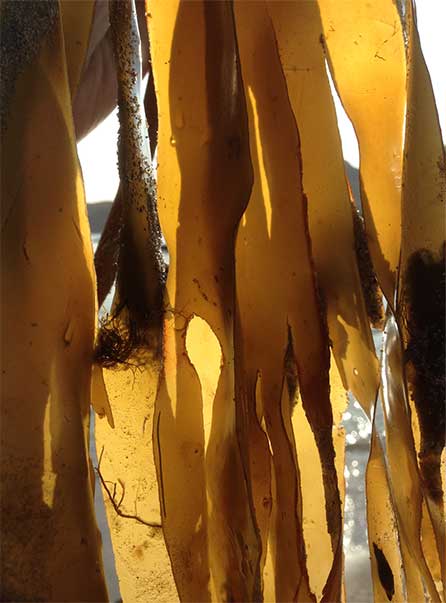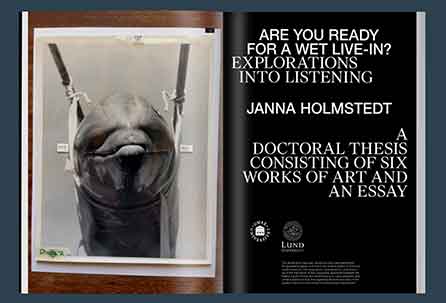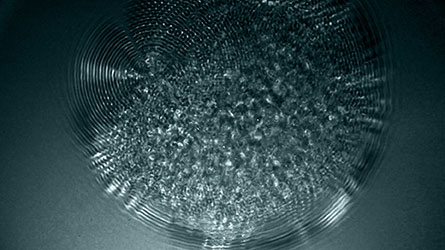| |

|
|
The Sea Garden: Cultivating Multispecies Futures, 2020 (ongoing)
Building on the long tradition of allotment gardens, this study explores the possibility of starting up community sea gardens in Sweden as small-scale ocean-farming initiatives on a non-commercial basis, where production is not main priority but multispecies co-habitation. The study combines speculative fabulations with hard core science and develops insights gained during The Posthumanities Hub's participation in the Kelp Congress, Lofoten International Art Festival 2019 and the two research strands Kelp Curing, navigated by Sarah Blissett, and Coast Line, navigated by Futurefarmers (Amy Franceschini & Lode Vranken). In a co-written chapter, Cecilia Åsberg, Janna Holmstedt and Marietta Radomskwe of the Posthumanities Hub, have proposed a novel posthumanist methodology for theorizing human-environment relations and multispecies care. See “Methodologies of Kelp: On Feminist Posthumanities, Transversal Knowledge Production and Multispecies Ethics in an Age of Entanglement.” In: The Kelp Congress, edited by N. Cahoon, H. Mehti and A. Wolfsberger, Svolvær: The North Norwegian Art Centre. The project is part of The Water Market, curated by Mossutställningar at Strömparterren, Stockholm (August 2020).
|
|

|
|
Humus economicus, 2020 (ongoing)
This project inquiries into the value and future of soil in urbanized landscapes and attends to soil as a collaborator. It mobilizes a team of artists, environmental-, urban-, gender-, and heritage scholars, and connects with a growing number of soil stewards – from farmers and activists to researchers and planners – to counteract soil blindness; decolonize conceptualizations of nature; and transform public knowledge and imaginaries of soils. The project has not yet been publicly presented, a film is in the malking. Artistic collaboration with Malin Lobell, artist and gardener, and Karin Wegsjö, film maker and director.
|
| |

|
|
Coming into Being, 2019 (ongoing)
A joint artistic development project in collaboration with Åsa Cederqvist. In this ongoing investigation we create, through a series of experimental sessions with invited guests, speculative fabulations with the earthworm as companion and guide. What can we learn from these ancient transformation masters, soil-makers and great digestive fermenters? Into this compositional and decompositional process we bring sound, soil, play, sculptural objects, film, performance and storytelling. The sessions are both scripted and improvised in order to allow for open-ended and co-creative processes to emerge.
Read more >> |
| |



|
|
A Feeling for the Organism, 2018 (ongoing)
This process oriented artistic research project (ongoing since 2018) is interrelated and partly overlaps with the project Anthropomorphic Interfaces, and has developed in conjuction with Storying Exposure (Pi: Cecilia Åsberg, KTH, and Hayden Lorimer, Glasgow University), a collaborative, interdisciplinary initiative and international gathering of Environmental Humanities researchers.
A Feeling for the Organism takes a small community garden in the city of Stockholm and a handful of maize seed as its point of departure. The seeds were a gift, but it turned out that this specific kind of maize was no ordinary corn. It is genetically very rich and diverse, and has been developed from over 70 different native American corn varieties from North America. Many of the heirloom cultivars it originates from are now extinct. Through interlacing the genetic research of Barbara McClintock (who coined the phrase "a feeling for the organism"), with the parallel inquiries into the ancient art of growing maize cultivated by Indigenous people in the Americas, and the history of the allotment movement in Europe, which gave poor urban workers access to land to grow their own food, A Feeling for the Organism attends to radically changing human-soil relations and the impact of monocultural thinking, in an attempt to creatively unlearn ingrained cultural patterns and regain a feeling for complex relational tangles and nonhuman organisms that are vital for human survival.
Read more >>
|
| |


|
|
Sonic Sensibilities, 2019
Sonic ecologies and modes of listening were further explored in the joint artistic development work Sonic Sensibilities, in collaboration with Jacek Smolicki, where our respective interests and different approaches to listening practices and sound technologies could meet. Through a series of curated public events at specific sites, and departing from various sound archives and the desire to communicate with other beings, our investigation of what a sonic sensibility might entail took form. The aim was to cross fertilize approaches and methods, and develop artistic and curatorial strategies that nurture attentive modes of listening.
Read more >>
|
| |


|
|
Anthropomorphic Interfaces, 2018-2019
Interspecies relations and aesthetic infrastructures were further explored in the artistic development work Anthropomorphic Interfaces in collaboration with Lars Siltberg and Erik Nilsson, with support from The Swedish Arts Grants Committee, Visual Arts Fund (project grant, initiator and project leader, Janna Holmstedt). The aim was to share and develop site-specific skills and sensibilities through place-based interventions outdoors, and to cultivate spatial and narrative strategies by mixing film, performance, sound and text. We used the script as tool, and expanded cinema as format, i.e. an expanded understanding of "film" as a spatial, temporal, material and social apparatus. The chosen site, an urban allotment, became a significant collaborator during the process as we returned to the same site during one year in shifting seasons and circumstances.
Read more >>
|
|

|
|
Book: Are You Ready for a Wet Live-In? Explorations into Listening
This doctoral thesis in fine arts consists of six artworks and an essay that documents the research process, or rather, acts as a travelogue as it stages and narrates a series of journeys into a predominantly sonic ecology. E-book with sound and film published Oct 6, 2017, available at Lund University research portal
Read
more >> |
| |



|
|
Are You Ready for a Wet Live-In? Explorations into Listening, 2010-2017
Doctoral research project (parental leave 2011-2012 and 2013-14). This artistic research project in fine arts inquiries into human-animal relationships, sound recording technologies, and the philosophy of sound, and how artists have explored and navigated various media ecologies and tangled relations between bodies, technologies and environments – from the early days of sound recording technologies to contemporary forms of expanded and mixed media art today. It investigates the phenomenon of the disembodied voice, participatory methodologies, mixed media realities, material modes of storying, and composition in the expanded field from a new materialist perspective. It also visits new areas of perception and experience that sound technology has made possible: from early experiments in film and sound art, to the discovery of whale songs in the deeps of the oceans, via outer space with the hope of communicating with other intelligent life, to the womb and the sound environment of the fetus.
I approach listening as a form of co-habitation in a fluid and dynamic environment through a series of artworks, or set-ups, that make use of voices, bodies, sound, storied environments, and constructed situations. Between 2012–2017 the artworks have been presented at different venues and in a variety of contexts, either as installations, performances, praxis sessions, or lecture performances, as well as in symposiums, conferences and seminars.
The dissertation is available as e-book with sound and film in DIVA and at Lund University research portal
Read
more >> |
| |


|
|
Fictionalized situations, 2008-2009
A two-year work grant (Swedish Arts Grants Committee) gave me the opportunity to engage in a longer and more consistent exploration of what I had come to call "fictionalized situations", i.e. performative, mixed media installations composed for three participants. In this artistic development work, I explored various observer- and participant positions and place-based narrative strategies that operated according to the device "what you see is not what you get". The body-as-image-for-others was set on collision course with the body-as-lived-experience, through the use of voices, objects, sound, bodies, and constructed environments – in the gallery space and in public spaces. The work was developed during three residencie s– at Bemis Center of Contemporary Art in Omaha, Nebraska (2007), Kunst:raum sylt quelle, at Sylt, Germany (2009) and Sumu, in Turku, Finland (2009) – and in works such as To Put Together with Light shown at Bemis Center (2007) and in a solo exhibition at 300m3 Art Space, Göteborg (2008); Paranormal at Konsthall C, Stockholm (2009); Environmental Dependency Syndrome, shown in the group exhibition Sonic Sunrises - Nordic Sound Art, at Titanik Gallery, Turku, Finland and in a slightly different version in Platform, curated by Edi Muka at Röda Sten Art Center, Göteborg (2010).
|
| |

|
|
Monument
for the Masses, 2005-2006
A two-year artistic development work by the artist duo Trial and Error (initiated by Janna Holmstedt, in collaboration with Po Hagström), and an investigation into monuments, the phenomena of counter-monuments in Post-Soviet countries, and the use of public art in Sweden and Estonia. Presented in a solo exhibition at Linnagallerii, Tallinn, curator Anders Härm, 2006, and the group exhibitions Supermarket, Konstnärshuset, Stockholm, 2007, Liljevalchs Vårsalong, curated by Maria Lind, Liljevalchs konsthall, Stockholm, 2007, and Sollentuna Art fair, Stockholm, 2008. The project website was in 2007 included in Rhizome.org ArtBase, an archive of new media art hosted by the New Museum of Contemporary Art, New York. The following articles have been published: "Welcome to ESTonia. En roadmovie i fem delar", Paletten No. 270-271, 2008. ”Some Day They’re Gonna Name a Street After Me”, Estonian Art No. 2, 2006.
Read
more >> |
| |
|
|

|
|
We
Invite All, 2004-2005
A research and exhibition project by the workgroup AUPG, initiated
by Sören Grammel and Jan Verwoert. Exhibited at BildMuséet,
Umeå, Sweden, 2006 and in "Whatever happened to social
democracy?" at Rooseum, Malmö, Sweden, 2005.
Read more >> |
| |
|
|
|
|